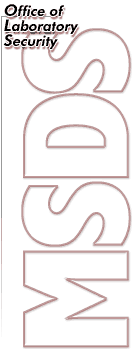

  |
|||||||||||||||||

|
MATERIAL SAFETY DATA SHEET - INFECTIOUS SUBSTANCES SECTION I - INFECTIOUS AGENT NAME: Epidermophyton floccosum, Microsporum spp., Trichophyton spp. SYNONYM OR CROSS REFERENCE: Dermatophytes, dermatomycosis, tinea, ringworm, Epidermophytosis, Trichophytosis, Microsporosis CHARACTERISTICS: Form hyphae and arthrospores in keratinized tissue, develop characteristic colonies and conidia in culture, sexual spores in some species SECTION II - HEALTH HAZARD PATHOGENICITY: Mycotic disease of keratinized areas of the body (hair, skin and nails) and of variable severity depending on genera and species of dermatophyte; usually scaling or hair loss or breakage, sometimes erythema, induration, crusting or suppuration; lesions often circular or annular because of central healing EPIDEMIOLOGY: Worldwide, relatively frequent; more common in hot, humid climates with crowding or debilitation; season prevalence varies with age; males are infected more often than females HOST RANGE: Humans, domestic and wild animals (depending on genera and species of dermatophyte - host specific) INFECTIOUS DOSE: Unknown MODE OF TRANSMISSION: Direct or indirect contact with skin or scalp lesions of infected people or animals or fomites ( floors, shower stalls, clothing) contaminated with desquamated epithelium INCUBATION PERIOD: 4-10 days COMMUNICABILITY: Communicable as long as infective lesions are present and viable SECTION III - DISSEMINATION RESERVOIR: Humans - anthropophilic; animals - zoophilic; soil - geophilic ZOONOSIS: Yes; farmers, livestock handlers, laboratory workers, and persons who milk infected animals are at greater risk VECTORS: None SECTION IV - VIABILITY DRUG SUSCEPTIBILITY: Griseofulvin ( several months treatment), miconazole, clotrimazole, itraconazole, fluconazole - depending on agent; topical treatment tolnaftate, halopregin, ciclopirox olumine SUSCEPTIBILITY TO DISINFECTANTS: Susceptible to 1% sodium hypochlorite, phenolics, glutaraldehyde, formaldehyde PHYSICAL INACTIVATION: Inactivated by moist heat (121░ C for at least 15 min) SURVIVAL OUTSIDE HOST: Agents survive for months to years in dry, cool, shaded areas SECTION V - MEDICAL SURVEILLANCE: Monitor for symptoms; confirm by microscopic examination of scrapings, culture FIRST AID/TREATMENT: Bathing with soap and water and topical application of appropriate fungicide IMMUNIZATION: None PROPHYLAXIS: None SECTION VI - LABORATORY HAZARDS LABORATORY-ACQUIRED INFECTIONS: Sixth most commonly reported laboratory-acquired infection; 161 reported cases most frequently associated with T. mentagrophytes; most acquired through contacts with naturally or experimentally infected laboratory animals (mice, rabbits, guinea pigs) and rarely, with handling cultures; processing of clinical material has not been associated with laboratory infections SOURCES/SPECIMENS: Skin, hair nails of human and animal hosts PRIMARY HAZARDS: Contact with infected laboratory animals with inapparent or apparent infections SPECIAL HAZARDS: None SECTION VII - RECOMMENDED PRECAUTIONS CONTAINMENT REQUIREMENTS: Biosafety level 2 practices, containment equipment and facilities for all laboratory and experimental animal activities with dermatophytes PROTECTIVE CLOTHING: Laboratory coat; gloves when handling infected materials OTHER PRECAUTIONS: Good sanitation, cleaning and disinfection important SECTION VIII - HANDLING INFORMATION SPILLS: Allow aerosols to settle; wearing protective clothing, gently cover spill with paper towels and apply sodium hypochlorite, starting at perimeter and working towards the centre; allow sufficient contact time (30 min) before clean up DISPOSAL: Decontaminate before disposal; steam sterilization, incineration, chemical disinfection STORAGE: In sealed containers that are appropriately labelled SECTION IX - MISCELLANEOUS INFORMATION Date prepared: March, 2001 Prepared by: Office of Laboratory Security, PHAC Although the information, opinions and recommendations contained in this Material Safety Data Sheet are compiled from sources believed to be reliable, we accept no responsibility for the accuracy, sufficiency, or reliability or for any loss or injury resulting from the use of the information. Newly discovered hazards are frequent and this information may not be completely up to date. Copyright © [Material Safety Data Sheets - Index]
|
| Last Updated: 2001-05-15 | |||